Papua New Guinea Provinces
EASTERN HIGHLANDS PROVINCE
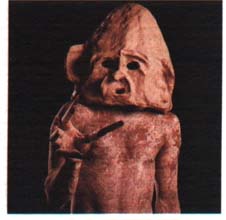 With
a history of gold mines and coffee plantations,
Eastern Highlands Province has had more
exposure to European influence than any
of the other Highlands provinces. It has
a history full of colourful characters -
miners, missionaries, patrol officers, plantation
owners. Traditional dress is seldom worn
these days, although the Highlanders still
live in villages of neat clusters of low
walled round huts built amongst the rolling
kunai-grass covered hills. With
a history of gold mines and coffee plantations,
Eastern Highlands Province has had more
exposure to European influence than any
of the other Highlands provinces. It has
a history full of colourful characters -
miners, missionaries, patrol officers, plantation
owners. Traditional dress is seldom worn
these days, although the Highlanders still
live in villages of neat clusters of low
walled round huts built amongst the rolling
kunai-grass covered hills.
Goroka, a small outpost station in the
1950's, has developed into an attractive,
well organised town with modern facilities
and relaxed atmosphere. It is a major Highlands
commercial centre of 25,000 people and at
an altitude of 1600 metres it has a climate
of perpetual spring.
Today Goroka has become known for its annual
show, held every August. It is a marvellous
opportunity to gain an overview of PNG's
cultural diversity. The shows were first
held in the 50's as a means of gathering
together the different tribes and clans.
At times there could be more than 40,000
painted warriors dancing to the beat of
the Kundu drums. The scenario was an amazing
success and grew from its original concept
of a local get-together into a major tourist
attraction.
Amongst the performers are the legendary
mud men of Asaro. Tribal folklore records
that centuries ago the warriors of Asaro
were defeated in a tribal fight with a neighbouring
village. Honour compelled the men to retaliate
with a "payback" raid, and, to
make themselves look fierce in the process,
covered their bodies with grey mud. According
to legend, the ruse worked, and their enemies
fled at the sight of these ghostly apparitions.
The mud men recreate the drama at the Goroka
show and for hotel tour groups.
The Raun Raun Theatre Company, based in
Goroka is a highly acclaimed performing
group which tours both nationally and internationally.
The theatre is located near the market,
just a short walk from the town centre.
The J.K. McCarthy Museum in Goroka is named
after one of Papua New Guinea's legendary
patrol officers. It is second only to the
National Museum in Port Moresby and exhibits
a wide variety of artefacts, handicrafts,
war relics and a collection of photographs
which portray early contact between Europeans
and Highlanders.
From the Post Office, the street leads
to a track that climbs to Mt Kiss lookout.
A long steep walk ends with a magnificent
vista across the valley. More serious trekking
can be found south of Goroka at Lufa, the
base of Mt Michael. There is a cave nearby
with some interesting prehistoric paintings.
From Goroka on the old road to Kainantu
is the village of Bena Bena, a centre for
weaving. The men operate the hand looms,
weaving pleasantly coarse rugs, bedspreads
and place mats.
Eleven kilometres out of town by four wheel
drive is the Mt Gahavisuka Provincial Park.
This is an area of around 80 hectares set
in beautiful mountain scenery. The Park
includes a botanical sanctuary, where exotic
plants from all over PNG have been added
to the local, natural orchids and rhododendrons.
There are clearly marked walking tracks
and a lookout at 2450 metres with panoramic
views.
Hotels can arrange day tours to any of
the attractions near Goroka including visits
to working coffee plantations, processing
plants and the Kotuni trout farm - a favourite
on local menues.
There are a number of options for accommodation
in Goroka, ranging from the top of the range
Bird of Paradise Hotel to the Teachers College
Campus.
Air Niugini has daily direct flights to
Goroka from Port Moresby. Third level airlines
also provide connections to Goroka from
various centres. Local PMV buses travel
regularly between Lae and Goroka.
Map of Eastern Highlands
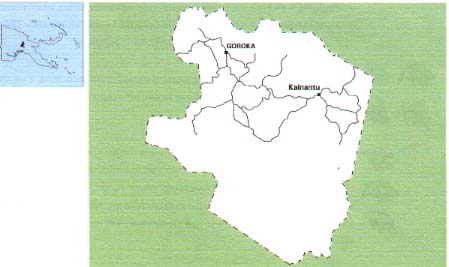
EAST NEW
BRITAIN PROVINCE
 Beautiful
Rabaul, half buried during the 1994 volcaniceruptions,
is re-emerging as a tourist destination
with a difference. There are few places
where the dramatic consequences of the contrasting
moods of nature can be experienced so intimately. Beautiful
Rabaul, half buried during the 1994 volcaniceruptions,
is re-emerging as a tourist destination
with a difference. There are few places
where the dramatic consequences of the contrasting
moods of nature can be experienced so intimately.
The drive from the airport, now located
at Tokua about an hour from Rabaul, is along
a narrow road winding its way around the
glittering waters of the Gazelle Peninsula.
Through the coconut trees villages of thatched
huts surrounded by colourful flowerbeds
and tropical fruit trees look out over calm
waters. The Tolai children with their bleached
hair and wide smiles stop their play to
wave at passing traffic.
Across the Harbour is Tavurvur, bellowing
great clouds of black-ash filled smoke,
some days grumbling, other days bellowing.
From this warm tropical lushness enter the
now lunar-like landscape at the base of
the volcano, Vulcan. Further on, pass through
untouched suburban streets before turning
into the main street of Mango Avenue. Amidst
the tangled mass of rubble and ruins covered
in layers of muddy volcanic ash, three former
resort hotels have been resurrected and
stand like oases amidst the desolation to
welcome the awe-struck visitor.
The history of Rabaul is one of wreckage
and regrowth. Modern historians will find
a treasure trove of World War 2 relics,
tunnels and caverns to explore within driving
distance of Rabaul. Close to the now thriving
centre of Kokopo, are the remnants of Gunantambu
mansion, built in the 1880's by the legendary
"Queen Emma".
War wrecks also litter the surrounding
reefs. The excellent visibility makes this
an exciting dive spot all year round. Dive
trips, day tours as well as charter boats
for fishing can be organised through any
of the hotels.
Out of Rabaul, along the north coast road
to Kabakada is the Kulau Lodge. Located
on the beach front, it is built in traditional
style of woven kunai grass. It is surrounded
by gardens and the large, airy restaurant
provides a relaxing area to enjoy the magnificent
views across the sea.
Forty five minutes by boat from Kokopo
are the Duke of York Islands offering sport
diving, snorkelling and picnics under the
coconut trees. The lagoons around this historical
group of islands provide all-weather canoeing,
wind surfing and skiing and are a haven
for visiting yachts.
There are daily Air Niugini flights to
Rabaul.
Map of East New Britain
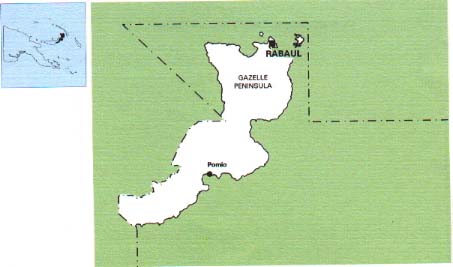
ENGA PROVINCE
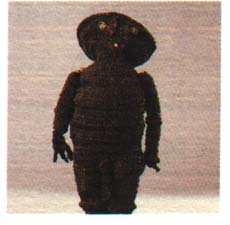 Enga
Province, sharing a border with Western
Province, features rugged mountains, high
valleys and fast flowing rivers. The Engan
people are a hardy race living mostly by
subsistence farming. Tribal warfare is still
a common way to settle inter-tribal disputes
and ceremonial life encompasses the giving,
receiving and displaying of wealth. Enga
Province, sharing a border with Western
Province, features rugged mountains, high
valleys and fast flowing rivers. The Engan
people are a hardy race living mostly by
subsistence farming. Tribal warfare is still
a common way to settle inter-tribal disputes
and ceremonial life encompasses the giving,
receiving and displaying of wealth.
Ceremonies are presided over by tribal
elders, distinguished by their two-metre
high head-dress displaying the brilliant
colours of plumes from the bird of paradise.
Proud warriors painted in bright ochre dance
long into the night to the beat of the Kundu
drums. The ceremonial singsing can last
for days during which time many pigs, the
greatest symbol of wealth, will be presented
as gifts. Men will slaughter and prepare
a feast of pork, green leaves and vegetables
cooked in a deep earth pit over hot coals.
After several hours it is shared amongst
the guests with the choice cut being offered
to the guest of honour.
Monetary wealth has come to the Engan landowners
since the introduction of coffee plantations
and more importantly the development of
the Porgera gold and silver mine, estimated
to be the largest gold mine outside South
Africa. Despite the wealth, development
of infrastructure has been slow. The rugged
terrain does not lend itself well to progress.
Landslides and broken bridges are common
along country roads and walking is often
the only alternative to travel by four wheel
drive.
Trekking enthusiasts will find their efforts
rewarded by the magnificently unspoilt surroundings.
In the west of the province is Laiagam.
The Botanical Gardens here have a collection
of over 100 species of native orchids and
more than thirteen species of rhododendrons.
Lake Rau, in the middle of Enga, is a crater
lake 3000 metres above sea level. It is
a day's walk from the nearest village of
Pumas. A guide is recommended.
Wabag is the provincial headquarters. It
is about four hours drive by bus or four
wheel drive from Mt Hagen. The Wabag Cultural
Centre includes a museum with a fine display
of wigs, war shields and masks and an art
gallery. The centre also houses a workshop
where young artists are taught the skills
of sand painting, an art form unique to
Enga Province. Using ground stone in natural
hues as a medium, the sand painters create
landscapes and legendary figures on a base
of wood or plasterboard. The centre is open
from 9.00 am to 4.00 pm week days.
There are several comfortable lodges to
stay in and around Wabag including the Kaiap
Orchid Lodge, the Wabag Lodge and the Malya
Hostel, a budget priced mountain hideaway.
All lodges will arrange transfers and day
tours.
Map of Enga
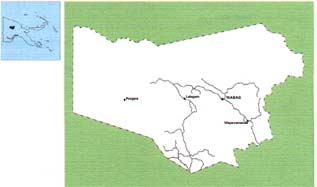
EAST SEPIK
PROVINCE
 One
of the world's largest waterways, the Sepik,
snakes it's way through East Sepik Province.
Dense rainforest covers the north coast
and the mountains north and south of the
river basin. Birdlife and rainforest creatures
splash colour across the blue and green
hues. Sepik fishermen in their dugout canoes
wave to visitors on the great white catamaran,
the "Melanesian Explorer", as
it plies it way down the river taking passengers
on a journey which will impress an unforgettable
image of the magnificence of Papua New Guinea. One
of the world's largest waterways, the Sepik,
snakes it's way through East Sepik Province.
Dense rainforest covers the north coast
and the mountains north and south of the
river basin. Birdlife and rainforest creatures
splash colour across the blue and green
hues. Sepik fishermen in their dugout canoes
wave to visitors on the great white catamaran,
the "Melanesian Explorer", as
it plies it way down the river taking passengers
on a journey which will impress an unforgettable
image of the magnificence of Papua New Guinea.
The Sepik River, often compared to the
Amazon and Congo Rivers, presents nature
untamed and unspoilt. See it from the comfort
of the "Melanesian Discoverer"
or the "Sepik Spirit", a luxury
twelve berth flat-bottom river cruiser.
For the more adventurous, the Karawari Lodge
on the Karawari River south of the Sepik
is a quality but very remote jungle tourism
lodge, or spend some time in a guest house
in the villages along the river.
Wewak, with its palm fringed beaches is
the main town of East Sepik. Not far from
Wewak is Cape Wom, the site of the Japanese
surrender where Lieutenant General Adachi
signed the surrender documents and handed
his sword to Major General Robertson on
13th September 1945. A war memorial marks
the site and the wartime airstrip is still
in place. Another memorial in town has been
erected at the site of the Japanese war
graves and nearby is the Japanese/PNG Peace
Park.
Accommodation in Wewak, while not luxurious,
provides adequate facilities as a base for
day trips to one of the 15 islands off the
coast of Wewak. Idyllic tropical islands
become a reality when you travel by boat
to Kairiru Island with its waterfalls and
hot springs. Swimming and snorkelling are
superb in these clear turquoise waters.
Diving is simply spectacular. Virtually
unknown and untouched, the waters and reefs
display an abundance of sea life - turtles,
sharks, manta rays, tuna, corals as well
as sunken wrecks from World War 2.
Map of East Sepik
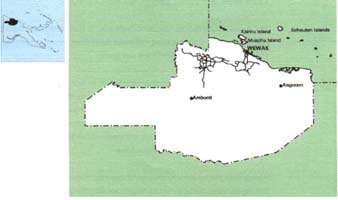
GULF PROVINCE
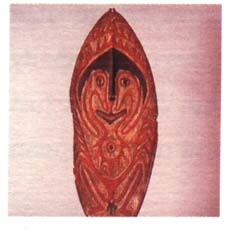 Gulf
Province, located on the southern coast
of Papua New Guinea is dominated by highland
mountains, lowland river deltas and wide
expanses of seasonally flooded grass plains.
The Turama, the Kikori, the Purari and the
Vailala are just some of the great rivers
that flow into the swampy, delta-land of
the Papuan Gulf. Gulf
Province, located on the southern coast
of Papua New Guinea is dominated by highland
mountains, lowland river deltas and wide
expanses of seasonally flooded grass plains.
The Turama, the Kikori, the Purari and the
Vailala are just some of the great rivers
that flow into the swampy, delta-land of
the Papuan Gulf.
The people of the delta-land build their
houses on piles high above the muddy river
banks. As the rivers change course they
frequently have to move their villages.
Each village is centred around the men's
longhouse, known as a dobu or ravi, where
weapons, important artefacts, ceremonial
objects and, in the past, the skulls of
enemies were stored. Men slept in the longhouse,
women in smaller, individual huts outside.
Cannibalism was a way of life for the fierce
gulf people until the arrival of Christianity.
Although head-hunting has not survived European
civilisation, seven distinct styles of artistic
craftsmanship have been categorised. A thriving
market for carved masks, bull roarers, headrests,
skull racks and gope boards keeps local
craftsmen busy.
Gope boards are elliptical in shape and
incised with brightly coloured abstract
patterns. Warriors were entitled to have
a gope board for each act of bravery and
a board from the vanquished enemy's canoe
held particular significance, transferring
some of its previous owner's strength to
the victor.
Delta towns Kikori and Baimuru, although
set well back from the coastline, are both
serviced by coastal freighters. Canoes are
still an important means of transport for
villagers. The provincial centre of Kerema
enjoys its government status solely because
it is situated to the east of the lowland
delta region and is drier. The town affords
most of the basic amenities and services.
Very few tourists visit the Gulf and tourism
facilities are not readily available. Keen
fishermen and canoeists visit the area and
bushwalking expeditions have retraced the
journeys of earlier explorers. Trekking
to Wau through the Bulldog Road, created
in the early 1900's during the gold exploration
epic, is one such route. There are some
guest houses available and village stays
can be arranged.
The Moale Festival commemorates the traditional
Motuan trade voyage from Central Province
to the Gulf, in search of sago in exchange
for the Motuan clay pots. This event is
held every September. In November the Provincial
School of Arts and Crafts holds its annual
festival.
Gulf Province has about 500 kms of roads,
mainly along the eastern coast and mountains.
River and sea transportation is the popular
mode of travel. Third level airlines also
serve this part of the country.
Map of Gulf

|